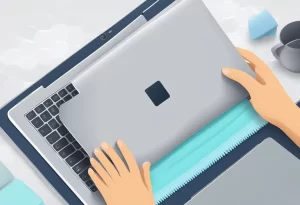
Laptop keyboard protectors are essential accessories that safeguard the keyboard from dust, spills, and other forms of damage. Applying a keyboard protector is a simple process that can be done by anyone, even without prior experience. This article provides a step-by-step guide on how to apply a laptop keyboard protector.
Before applying a keyboard protector, it is important to understand the different types of protectors available in the market. Keyboard protectors come in various materials such as silicone, TPU, and vinyl. Each material has its own advantages and disadvantages, and it is important to choose a protector that best suits your needs.
To apply a keyboard protector, you will need a few tools such as a microfiber cloth, a pair of scissors, and a ruler. Before applying the protector, it is important to clean the keyboard thoroughly to remove any dust or debris. Once the keyboard is clean, you can proceed to apply the protector using the step-by-step guide provided in this article.
Key Takeaways
- Understanding the different types of keyboard protectors available in the market is essential before choosing the right protector for your laptop.
- Proper preparation before application is crucial to ensure a smooth and successful process.
- Following a step-by-step guide is the most effective way to apply a laptop keyboard protector.

Credit: Youtube
Understanding Laptop Keyboard Protector
Keyboard protectors are thin, flexible sheets that are placed over laptop keyboards to protect them from dust, spills, and other types of damage. These protectors are made from various materials such as silicone, TPU, and PET.
Silicone keyboard protectors are the most popular type of keyboard protector due to their durability and flexibility. They are made from a soft, rubber-like material that is easy to clean and provides a comfortable typing experience. TPU and PET keyboard protectors are also available, but they are not as common as silicone protectors.
Keyboard protectors come in different sizes and shapes to fit different laptop models. Before purchasing a keyboard protector, it is important to measure the dimensions of your laptop keyboard to ensure a proper fit.
To apply a keyboard protector, clean the laptop keyboard, align the protector with the keys, and press down, smoothing it out from the center to the edges. Though protectors may add slight thickness, they help safeguard against spills, dust, and wear. A small trade-off for keeping your keyboard in top shape!

Choosing the Right Keyboard Protector
When it comes to choosing a laptop keyboard protector, there are a few things to consider. Here are some factors to keep in mind:
Material
Keyboard protectors come in a variety of materials, including silicone, TPU, and polyurethane. Each material has its own advantages and disadvantages. For example, silicone protectors are flexible and easy to clean, but they may not provide as much tactile feedback as other materials. TPU protectors are more rigid and offer better key response, but they may be harder to clean.
Compatibility
Make sure the keyboard protector you choose is compatible with your laptop model. Some protectors are designed specifically for certain laptop brands or models, while others are more universal. Check the product description or packaging to ensure that the protector will fit your laptop properly.
Thickness
Keyboard protectors come in different thicknesses, ranging from ultra-thin to more substantial. Thicker protectors may offer more protection against spills and debris, but they may also affect the feel of the keyboard. Thinner protectors are less noticeable but may not provide as much protection.
Ease of Application
Consider how easy the protector is to apply and remove. Some protectors require adhesive to stay in place, while others simply rest on top of the keyboard. Adhesive protectors may be more secure, but they can also be more difficult to remove without leaving residue.
Price
Keyboard protectors can vary in price, from a few dollars to more than $20. Consider your budget when choosing a protector, but keep in mind that a higher price doesn’t always mean better quality. Look for a protector that offers the features you need at a price that works for you.
By considering these factors, you can choose a keyboard protector that will provide the protection you need without compromising the feel or functionality of your laptop keyboard.
Tools Needed for Application

Before applying a laptop keyboard protector, there are a few tools that one should have on hand. These tools will make the application process easier and ensure that the protector is applied correctly.
Microfiber Cloth
A microfiber cloth is an essential tool for applying a laptop keyboard protector. It is used to clean the keyboard before applying the protector. The cloth should be clean and free of any dust or debris. A microfiber cloth is preferred because it is gentle and does not scratch the surface of the keyboard.
Keyboard Dusting Brush
A keyboard dusting brush is another tool that can be used to clean the keyboard before applying the protector. It is especially useful for removing debris that is stuck between the keys. The brush should be soft and gentle to avoid scratching the surface of the keyboard.
Keyboard Protector
Of course, the most important tool for applying a laptop keyboard protector is the protector itself. It is essential to choose a protector that is the correct size for the laptop’s keyboard. A good quality protector should be made of a durable material that will not tear or wear easily.
Scissors
Scissors may also be needed to trim the protector to fit the laptop’s keyboard. It is important to trim the protector carefully to ensure that it covers the entire keyboard without overlapping the edges.
Patience
Lastly, patience is a crucial tool for applying a laptop keyboard protector. It may take a few tries to get the protector aligned correctly and free of bubbles. Taking the time to apply the protector carefully will ensure that it lasts longer and provides better protection for the laptop’s keyboard.
Preparation Before Application

Before applying a laptop keyboard protector, it is important to prepare the keyboard surface to ensure that the protector adheres properly and lasts for a long time.
The following are some steps to take before applying a laptop keyboard protector:
Clean the Keyboard
The first step is to clean the keyboard thoroughly. Any dust, dirt, or debris on the keyboard can cause the protector to not stick properly. Use a soft, dry cloth or compressed air to remove any particles from the keyboard.
Check the Size
It is important to ensure that the keyboard protector fits the laptop keyboard properly. Check the size of the protector against the keyboard to make sure it covers all the keys.
Align the Protector
Align the protector with the keyboard keys before applying it. Make sure it is centered and straight. This will help ensure that the protector adheres properly and does not cause any inconvenience while typing.
Remove Air Bubbles
After applying the protector, remove any air bubbles that may have formed. Use a credit card or similar object to press down on the protector starting from the center and working your way outwards. This will help remove any air bubbles and ensure that the protector adheres properly.
By following these steps, you can ensure that the laptop keyboard protector is applied properly and lasts for a long time.
Step by Step Application Process
Applying a keyboard protector to your laptop is an easy way to keep your keyboard clean and protected from dust, dirt, and spills. Here is a step-by-step process for applying a laptop keyboard protector.
Cleaning the Keyboard
Before applying the keyboard protector, make sure to clean the keyboard thoroughly. Use a soft cloth or an electronic dusting brush to remove any dust or debris from the keyboard. This will ensure that the keyboard protector adheres properly to the keyboard.
Aligning the Protector
Align the top edge of the keyboard protector with the top of your laptop’s keyboard. Make sure that the protector is centered and that the edges line up with the keys on the keyboard.
Applying the Protector
Once the protector is properly aligned, gently press down on the center of the protector. Work your way from the center outwards, pressing down on the protector as you go. This will help to eliminate any air bubbles that may have formed.
Smoothing Out Bubbles
If any air bubbles remain after applying the protector, use a credit card or a similar object to smooth them out. Gently press down on the bubbles, working from the center outwards. This will help to eliminate any air bubbles that may have formed.
By following these simple steps, you can easily apply a keyboard protector to your laptop and keep your keyboard clean and protected.
Post Application Care
After applying a keyboard protector, it is important to take care of it to ensure that it lasts as long as possible. Here are some tips to help you take care of your laptop keyboard protector:
Cleaning
Cleaning the keyboard protector regularly can help prevent the buildup of dirt and grime. Simply remove the protector from the keyboard and rinse it with warm water. Use a mild soap if necessary. Allow the protector to air dry completely before putting it back on the keyboard.
Avoiding Harsh Chemicals
Harsh chemicals such as bleach or alcohol can damage the keyboard protector. Avoid using these types of cleaners when cleaning your laptop or keyboard protector.
Removing Stains
If you notice any stains on the keyboard protector, try removing them with a soft cloth or sponge and a mild soap solution. Avoid using abrasive materials or scrubbing too hard, as this can damage the protector.
Proper Storage
When not in use, it is best to store the keyboard protector in a clean, dry place. Avoid storing it in direct sunlight or in a humid environment, as this can cause it to deteriorate more quickly.
By following these simple tips, you can help ensure that your laptop keyboard protector lasts as long as possible, providing your keyboard with the protection it needs against dust, dirt, and spills.

I am a technology Specialized writer and blogger based in the USA & UK. I have four years of experience in Cyber Security, Technology, Social Media and all types of electronic devices like computer laptops etc. So I work on solving these issues and give various tips on these issues



